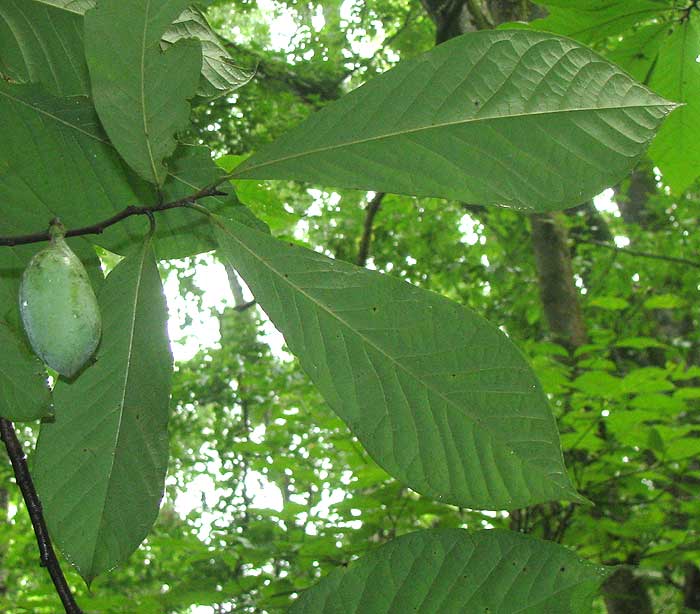Excerpts from Jim Conrad's
Naturalist Newsletter

from the July 15, 2012 Newsletter issued from the woods of the Loess Hill Region a few miles east of Natchez, Mississippi, USA
PAWPAWS
Notes from my days as a hermit near here indicate that pawpaw fruits in this area mature in mid August or so. However, my experience is that if I want a picture of pawpaws hanging on a tree I'd best take the picture before the fruits ripen, else critters will pick them before I get to them. Therefore, above you can see an immature pawpaw about 2-½ inches long (7cm) hanging on a Pawpaw tree on a rainy morning in mid July.
If you were with me in the Yucatan you may recognize the similarity between this pawpaw fruit and the various annonas, soursops and custard apples we sampled down there. That's because Pawpaw trees are members of the same mostly-tropical plant family, the Custard Apple Family or Annonaceae, as the trees producing those delicious fruits. Our pawpaw fruits share with those tropical fruits their general size, the sweet taste of their soft flesh, the largeness of their many seeds embedded throughout the flesh, the small size of the trees, and many technical features. In fact, Pawpaws can be thought of as Temperate-Zone outliers of a family much more developed in the world's tropics.
Certainly as a farm kid in Kentucky when I was lucky enough to get a ripe pawpaw fruit it seemed that I was tasting something so lavishly musky-sweet, syrupy and messy that it felt exotic and over-the-top in comparison to the surrounding more understated and parsimonious oaks, hickories, maples and ashes. Now I know it was true: Pawpaws were simply otherworldly.
Pawpaw trees are an understory species living their whole lives in shade beneath taller trees, and they like rich, moist soil. Here they don't occur on ridge tops, but on valley floors and lower slopes where sometimes they form dense colonies. Fruiting trees usually are about 15 to 20 feet tall (5-6m). Sometimes during fruiting season you find large populations occupying whole little valleys but not a single tree will bear a fruit. Other times nearly every mature tree will be fruiting.
The common Pawpaw found throughout most of the eastern US and southernmost Canada is Asimina triloba. I'm supposing that what's in the picture is ASIMINA PARVIFLORA, sometimes known as the Small-flowered, Small-fruited, and Dwarf Pawpaw, native to the US Deep South, mostly on the Coastal Plain from southeastern Virginia to eastern Texas. Its distribution overlaps considerably that of the Common Pawpaw of farther north. In Mississippi the Common Pawpaw, Asimina triloba, is mostly limited to the northern two-thirds of the state, while the Small-flowered species, Asimina parviflora, occurs throughout the state, extending no farther north than about the Tennessee border. The main difference between the two species is seen in the flowers, but I have no flowers. However, the University of Mississippi's Pullen Herbarium documents collections of the Small-flowered species from our southwestern corner of the state, but not of the Common.